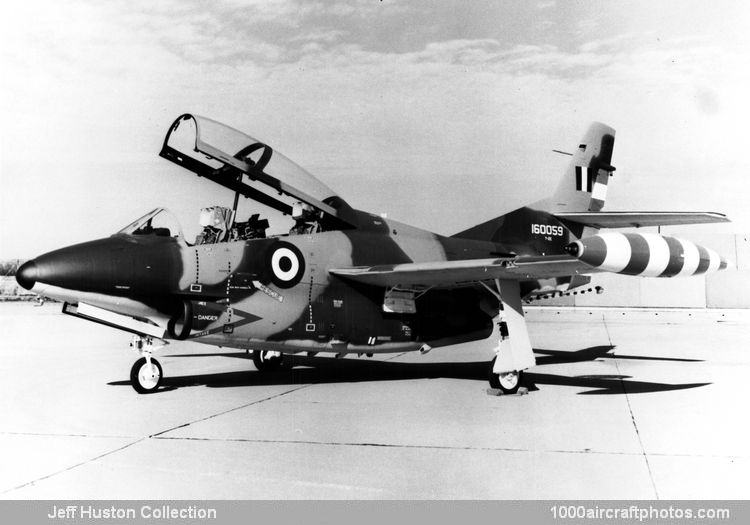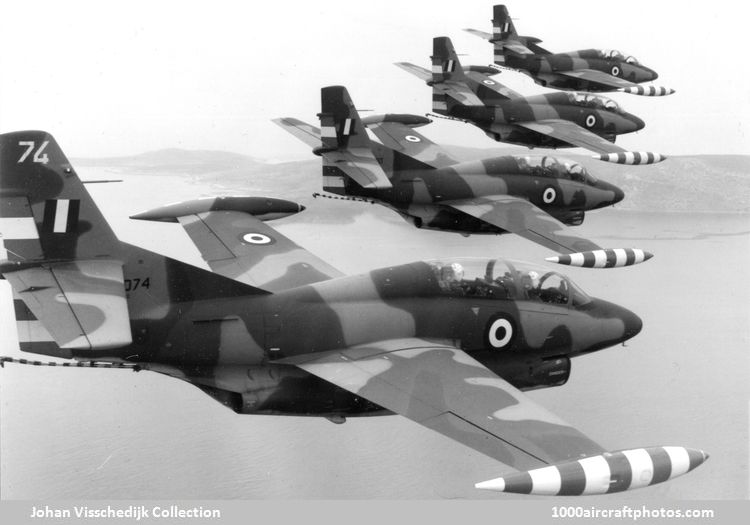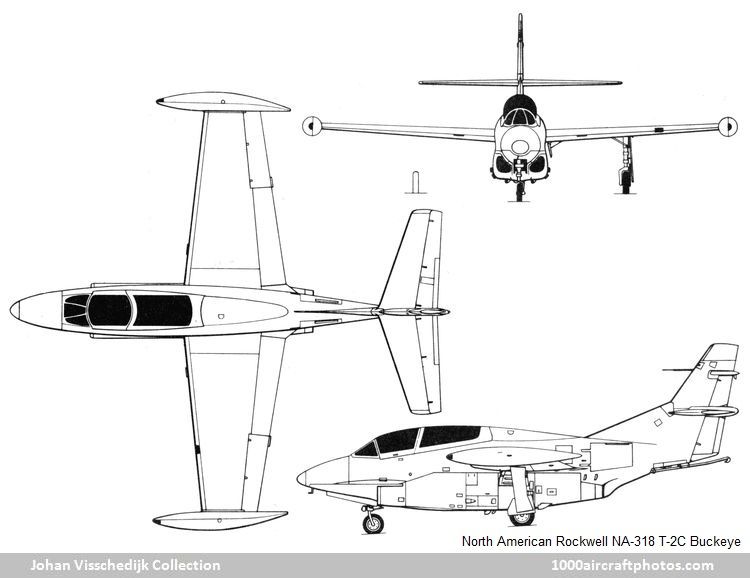12/31/2024. Remarks by
Johan Visschedijk: "With its NA-241 design, North Americans Columbus Division at Columbus, Ohio, was successful in meeting a USN requirement for a two-seat jet trainer. In common with many other Services around the world, the Navy was seeking a single aircraft capable of fulfilling a broad spectrum of training duties, taking students who had completed an ab initio course through all subsequent stages up to carrier qualification.
Design of the NA-241 was initiated in June 1956, for speed of development and low cost, North American adopted proven design features wherever possible, basing the NA-241 upon the wing of the FJ-1 Fury, with the control system based on that of the T-28C. The crew were seated in tandem on zero-level ejection seats specially developed for the aircraft by the Columbus Division. Bifurcated intakes were provided for a single 3,400 lb (1,542 kg) st Westinghouse J34-WE-36 jet engine located in the underside of the fuselage and the aircraft was designed for carrier operation and with capability to carry weapons under the wings for armament training.
The Navy backed the North American effort with a contract for six NA-249 YT2J-1 preproduction aircraft (redesignated YT-2A on September 18, 1962), first flight being made at Columbus by Dick Wenzell on January 31, 1958. Production orders for 211 T2J-1s followed and, after carrier qualification trials aboard the USS Antietam in May 1959, deliveries of T2J-1s began in July the same year. The name Buckeye, selected for the new trainer, is the nickname of the state of Ohio, where it was built. Squadrons of the Naval Air Basic Training Command became the primary users, VT-7 and VT-9 at Naval Air Station Meridian, Missouri, and VT-4 at NAS Pensacola, Florida. An ordered batch of 60 T2J-1s was cancelled, bringing the total of T2Js built to 217. The last T2J-1s were delivered in April 1961, the type was redesignated T-2A on September 18, 1962.
After production of the T2J-1 ended, North American developed a new version in which two 3,000 lb (1,361 kg) st Pratt & Whitney J60-P-6 engines replaced the single Westinghouse J34. One YT2J-1 (144218) and one T2J-1 (145997) were modified to YT2J-2 prototypes in this configuration as NA-280, the first flight being made on August 30, 1962. Only nineteen days later, September 18, the YT2J-2 prototypes were redesignated YT-2B. Production contracts for 112 T-2Bs followed, although 15 were cancelled, with the first flight on May 21, 1965 and deliveries to VT-7 and VT-9 starting one year later. After the first 33 T-2Bs had been built, a production change was made to add 100 gal (379 l) of fuel in wing leading edge tanks, and to fit longer undercarriage legs.
The third production series of Buckeyes resulted from substitution of 2,950 lb (1,338 kg) st General Electric J85 engines for the Pratt & Whitney J60s, the last three contracted T-2Bs were completed to this new T-2C standard. September 22, 1967, North American merged with Rockwell into North American Rockwell, April 17, 1968, the T-2C made its first flight. Production contracts for 264 followed (of which 36 were cancelled), with the first flight of a production T-2C being made on December 10, 1968 and production continuing into 1973.
During 1970, North American Rockwell received a contract from NASA to fit a supercritical wing on a T-2C. This project involved modifying a standard wing to have a thicker section with a flat top surface. Being the first aircraft to fly with a supercritical wing, it made its first flight with Ed.Gillespie at the controls at Columbus at the end of November 1970.
Later a small number of T-2B and T-2C trainers were converted to drone directors, redesignated DT-2B and DT-2C respectively. These aircraft, including two DT-2Bs (153551 c/n 294-14, 155238 c/n 310-33), were operated by the Pacific Missile Test Center for controlling target drones during missile testing.
Around 1970 North American Rockwell introduced an export version of the Buckeye. Designated T-2D, it was also promoted as the International Jet Trainer. Generally similar to T-2C, it differed only in new electronics equipment and by deletion of carrier landing capability. Twelve aircraft were supplied to the Venezuelan AF and these were used as advanced jet trainers for student pilots, delivery was completed during 1973. Subsequently North American Rockwell and the Rockwell Manufacturing Company merged to become Rockwell International. Under the name Rockwell an additional twelve aircraft, with an attack kit, had been delivered to Venezuela at the end of May 1977.
T-2E (160074, et al) (
Johan Visschedijk Collection)
The final Buckeye version was the T-2E, which was also generally similar to the T-2C, except for new electronics equipment and the provision of an accessory kit which permitted utilization in an attack role. A total of forty were supplied to Greece under a contract managed by US Naval Air Systems Command. The accessory kit provided six wing store stations with a combined capacity of 1,587 kg (3,500 lb), and protection against small arms fire for the fuel tanks. The aircraft are used by the Greek Air Force Training Command as advanced and tactical jet trainers for student pilots in their final stages of training. Delivery was completed in January 1977.
Around the year 2000, service parts for T-2E became scarce, while by that time the Greek AF had lost some T-2Es in crashes. As the T-2C and T-2E were general similar, Greece bought as attrition replacements five USN T-2Cs (157043, 157049, 158889, 158904, 158910), that had been stored at
AMARC at Davis-Monthan AFB for a number of years. These were transferred to Greece on May 26, 2000, where they received camouflage and Greek markings and were put into service.
Another seven T-2Cs (158321, 158601, 158909, 159159, 159173, 159705, 159722) were bought in 2010, these left AMARC between April 9 and May 18, 2010. In Greece these seven remained in USN markings and were cannibalized for spare parts. One of the first five attrition replacements T-2Cs (158904) was the last Buckeye that crashed in Greek AF service on December 27, 2023. In early 2024 the Buckeye was after 48 years of service finally withdrawn from use by the Greek AF.
Below a listing of all Buckeyes that were built."
The following details apply to the standard T-2C.
Wings: Cantilever mid-wing monoplane. Wing section NACA 64A212 (modified). Thickness/chord ratio 12%. All-metal two-spar structure. Interchangeable all-metal ailerons, with hydraulic boost. Large all-metal trailing-edge flaps.
Fuselage: All-metal semi-monocoque structure in three main sections: forward fuselage containing equipment bay and cockpit; center fuselage housing power plant, fuel and wing carry-through structure; and rear fuselage, carrying the arrester hook and a hydraulically-actuated airbrake on each side of the fuselage.
Tail unit: Cantilever all-metal structure. Each half of tailplane and elevators interchangeable. Elevators boosted hydraulically. Rudder manually controlled. Trim tabs in elevators and rudder.
Landing gear: Retractable tricycle type. Oleo-pneumatic shock-absorbers. Hydraulic retraction. Main units retract inward into wings. Nosewheel retracts forward into fuselage. Main wheels size 24 x 5.50. Nosewheel size 20 x 4.40. Main-wheel tire pressure 150 lb/sq.in (10.55 kg/sq.cm), nosewheel tire pressure 75 lb/sq.in (5.27 kg/sq.cm). Goodyear air-cooled single-disc hydraulic brakes. Retractable sting-type, universal joint mounted, arrester hook.
Power plant: Two 2,950 lb (1,338 kg) st General Electric 185-GE-4 turbojet engines, with jet outlets under rear fuselage. Fuel in main tanks over engines with capacity of 387 gal (1,465 l), two wingtip tanks each of 102 gal (386 l) capacity, and two tanks each of 50 gal (189 l) capacity in the inboard sections of the wings. Total fuel capacity 691 gal (2,616 l).
Accommodation: Pupil and instructor in tandem in enclosed cabin, on rocket-powered LS-1 ejection seats, under clamshell canopy. Instructor is raised 10 in (0.25 m) above level of pupil.
Armament: Optional packaged installations of guns, target-towing gear, 100 lb (45 kg) practice bombs, M-5 or MK76 practice bomb clusters, Aero 4B practice bomb containers, 2.25 in (57 mm) rocket launchers or seven 2.75 in (70 mm) rockets in Aero 6A-1 rocket containers, can be carried on two store stations, one beneath each wing, with a combined capacity of 640 lb (290 kg). Alternative option includes above package, plus four additional wing store stations, to provide a total underwing ordnance capacity of 3,500 lb (1,588 kg), and protection against small arms fire for the fuel tanks.



